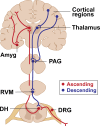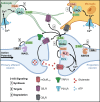Analgesic Properties of Next-Generation Modulators of Endocannabinoid Signaling: Leveraging Modern Tools for the Development of Novel Therapeutics
- PMID: 39060165
- PMCID: PMC11493443
- DOI: 10.1124/jpet.124.002119
Analgesic Properties of Next-Generation Modulators of Endocannabinoid Signaling: Leveraging Modern Tools for the Development of Novel Therapeutics
Abstract
Targeting the endocannabinoid (eCB) signaling system for pain relief is an important treatment option that is only now beginning to be mechanistically explored. In this review, we focus on two recently appreciated cannabinoid-based targeting strategies, treatments with cannabidiol (CBD) and α/β-hydrolase domain containing 6 (ABHD6) inhibitors, which have the exciting potential to produce pain relief through distinct mechanisms of action and without intoxication. We review evidence on plant-derived cannabinoids for pain, with an emphasis on CBD and its multiple molecular targets expressed in pain pathways. We also discuss the function of eCB signaling in regulating pain responses and the therapeutic promises of inhibitors targeting ABHD6, a 2-arachidonoylglycerol (2-AG)-hydrolyzing enzyme. Finally, we discuss how the novel cannabinoid biosensor GRABeCB2.0 may be leveraged to enable the discovery of targets modulated by cannabinoids at a circuit-specific level. SIGNIFICANCE STATEMENT: Cannabis has been used by humans as an effective medicine for millennia, including for pain management. Recent evidence emphasizes the therapeutic potential of compounds that modulate endocannabinoid signaling. Specifically, cannabidiol and inhibitors of the enzyme ABHD6 represent promising strategies to achieve pain relief by modulating endocannabinoid signaling in pain pathways via distinct, nonintoxicating mechanisms of action.
Copyright © 2024 by The American Society for Pharmacology and Experimental Therapeutics.
Figures




References
-
- Aaltonen NSingha PKJakupović HWirth TSamaranayake HPasonen-Seppänen SRilla KVarjosalo MEdgington-Mitchell LEKasperkiewicz P, et al. (2020) High-Resolution Confocal Fluorescence Imaging of Serine Hydrolase Activity in Cryosections - Application to Glioma Brain Unveils Activity Hotspots Originating from Tumor-Associated Neutrophils. Biol Proced Online 22:6. - PMC - PubMed
-
- Ahrens J, Demir R, Leuwer M, de la Roche J, Krampfl K, Foadi N, Karst M, Haeseler G (2009) The nonpsychotropic cannabinoid cannabidiol modulates and directly activates alpha-1 and alpha-1-Beta glycine receptor function. Pharmacology 83:217–222. - PubMed
-
- Alexander SPH (2016) Therapeutic potential of cannabis-related drugs. Prog Neuropsychopharmacol Biol Psychiatry 64:157–166. - PubMed
Publication types
MeSH terms
Substances
Grants and funding
LinkOut - more resources
Full Text Sources
Medical
